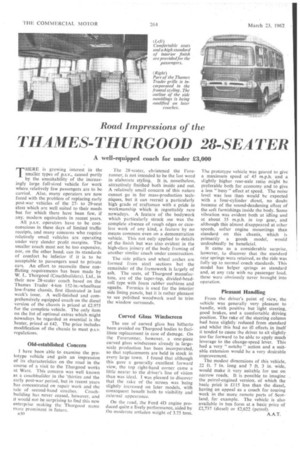Road Impressions of the
Page 64

If you've noticed an error in this article please click here to report it so we can fix it.
THAMES-THURGOOD 28-SEATER
A well-equipped coach for under £3,000
THERE is growing interest in the smaller types of p.s.v., caused partly by the unsuitability of the increasingly large full-sized vehicle for work where relatively few passengers are to be carried. Also, many operators are now faced with the problem of replacing early post-war vehicles of the 27to 29-seat class which are well suited to their needs but for which there have been few, if any, modern equivalents in recent years.
All p.s.v. operators have to be costconscious in these days of limited traffic receipts, and many concerns who require relatively small vehicles are operating under very slender profit margins. The smaller coach must not be too expensive, nor, on the other hand, can its standards of comfort be inferior if it is to be acceptable to passengers used to private cars. An effort to reconcile these conflicting requirements has been made by W. L. Thurgood (Coachbuilders), Ltd., in their new 28-seater coach based on the Thames Trader 4-ton 152-in.-wheelbase low-frame chassis, first illustrated in last week's issue. A well-finished and comprehensively equipped coach on the diesel version of the chassis is priced at £2.975 for the complete vehicle. The only item on the list of optional extras which might nowadays be regarded as essential is the heater, priced at £42. The price includes modification of the chassis to meet p.s.v. regulations.
Old-established Concern
I have been able to examine the prototype vehicle and gain an impression of its characteristics on the road in the course of a visit to the Thurgood works at Ware. This concern was well known as a coachbuilder in the 'thirties and the early post-war period, but in recent years has concentrated on repair work and the
sale of second-hand coaches. Coachbuilding has never ceased, however, and it would not be surprising to find this new enterprise making the Thurgood name more prominent in future.
n30
The 28-seater, christened the Forerunner, is not intended to be the last word in elaborate styling. It is, nonetheless, attractively finished both inside and out. A relatively small concern of this nature cannot go in for mass-production techniques, but it can recruit a particularly high grade of craftsman with a pride in workmanship which is regrettably rare nowadays. A feature of the bodywork which particularly struck me was the complete absence of rough edges or careless work of any kind, a feature by no means common even on a demonstration vehicle. This not only applied to details of the finish but was also evident in the high-class joinery of the body framing of another similar coach under construction.
The side pillars and wheel arches are formed from steel sections but the remainder of the framework is largely of ash. The seats, of Thurgood manufacture, are of the taper-top, divided-headroll type with foam rubber cushions and squabs. Formica is used for the interior side lining panels, but it is rather pleasant to see polished woodwork used to trim the window surrounds.
Curved Glass Windscreen
The use of curved glass has hitherto been avoided on Thurgood bodies to facilitate replacement in case of damage. On the Forerunner, however, a one-piece curved glass windscreen already in largescale production has been incorporated, so that replacements are held in stock in every large town. I found that although this gave a generally excellent forward view, the top right-hand corner came a little nearer to the driver's line of vision than was ideal. I was pleased to discover that the rake of the screen was being slightly increased on later models, with consequent benefit both to visibility and external appearance.
On the road, the Ford 4D engine produced quite a lively performance, aided by the moderate unladen weight of 3.75 tons. The prototype vehicle was geared to give a maximum speed of 45 m.p.h. and a slightly higher rear-axle ratio might be preferable both for economy and to give a less " busy " effect at speed. The noise level was less than would be expected with a four-cylinder diesel, no doubt because of the sound-deadening effect of the soft furnishings inside the body. Some vibration was evident both at idling and at about 35 m.p.h. in top gear, and although this almost disappeared at other speeds, softer engine mountings than standard on this chassis, which is primarily a goods model, would undoubtedly be beneficial.
It came as a considerable surprise. however, to discover that the standard rear springs were retained, as the ride was fully up to normal coach standards. This model has helper springs as standard and, at any rate with no passenger load, these were obviously never brought into operation.
Pleasant Handling From the driver's point of view, the vehicle was generally very pleasant to handle, with positive but light steering, good brakes, and a comfortable driving position. The rake of the steering column had been slightly reduced from standard and whilst this had no ill effects in itself it tended to cause the driver to sit slightly too far forward to be able to apply much leverage to the change-speed lever. This had a very " notchy " action and a suitable extension would be a very desirable improvement.
The modest dimensions of this vehicle, 22 ft. 7 in. long and 7 ft. 3 in. wide, would make it very suitable for use on narrow roads, It is possible to imagine the petrol-engined version, of which the basic price is £115 less than the diesel, having an appeal as a coach for touring work in the more remote parts of Scotland, for example. The vehicle is also available in bus form at a basic price of £2,737 (diesel) or £2,622 (petrol).
A.A.T.




















































































































